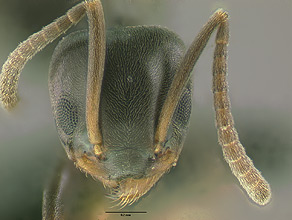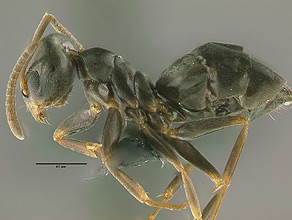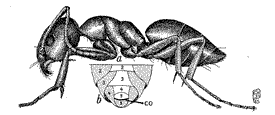- Identification
- A small Dolichoderine that has only the slightest of petiolar nodes and an unusual arrangement of its gastral segments. Unlike other species in this subfamily the final segment of the gaster is directed downward. This leads to the anal pore opening being located ventrally (click on the image below to see details of this character) as opposed to opening at the distal end end of the gaster.
- Biology
- Tapinoma sessile is one of the most widespread North American ant species. It is abundant in a wide range of habitats. It nests in the ground, under and within objects, in downed wood and will, in some cases, move into human structures.
- The small dark colored workers move about quickly during warm days but they will also forage during cooler temperatures that many other co-occurring ants avoid. When disturbed the highly excitable workers will swarm out of their nest and emit a distinctive pheromone.
- additional biology notes...
- Distribution
- Range
- S Canada, United States.
- Navajo Reservation Records
- Specimen records being processed.
- Additional Notes
- Nests of this species can contain thousands of workers and many queens. Workers tend Homoptera and will opportunistically forage on a wide variety of items, being especially attracted to liquid exudates that are rich in carbohydrates.
- M.R. Smith (1965), reporting on eastern U.S. pest ants, provides this description of their biology:
This common and widely distributed ant is one of our most adaptable species, occurring from sea level to 10,500 feet. It nests in a wide variety of habitats, ranging from sandy beaches, pastures, open fields, woodlands, and bogs, to houses. Most nests in the soil are beneath objects such as stones or logs, but this versatile species also nests under the bark of logs and stumps, in plant cavities, insect galls, refuse, piles, and bird and mammal nests. Nests in the soil are indefinite in form, shallow, and of little permanency. The colonies range in size from a few hundred individuals to many thousands, and contain numerous reproductive females. The individuals of the various colonies are not antagonistic to each other, but are hostile to the introduced Argentine ant. Mating takes place in the nest between males and their sister females, but nuptial flights have also been observed. Although females have been observed to establish colonies independently, it is also highly possible that the ants may form new colonies when one or more fertile females leave the parental colony accompanied by a number of workers. Workers are active and rapid, and normally travel in files. When alarmed, the workers dash around excitedly in an erratic manner, quite often with the posterior part of their abdomen elevated. Workers also emit from theip abdominal glands an odor which has been likened to that of rotten coconut. In Mississippi, male pupae have been noted from April 16 to 30, and males and winged females from May 1 to 15. In Bogs in southeastern Michigan, Kannowski has observed nuptial flights from Jime 26 to July 15. Few ants exceed sessile in their love for honeydew. Not only do workers eat honeydew avidly, but they assiduously attend such honeydew-excreting insects as plant lice, scale insects, mealybugs, and membracids. In some instances, workers have been observed transporting live plant lice. When mealybugs have been disturbed by collectors, the worker ants have tried to pick them up and carry them away. Workers visit the floral and extrafloral nectaries of plants in search of their glandular secretions. Like many species of ants, the workers feed on both dead and live insects.
T. sessile, one of our more important house infesting ants, is capable of invading houses from outdoors, or nesting inside. Although the ants feed on a wide variety of household foods, such as raw and cooked meats, cooked vegetables, dairy products, fruit juices, and pastries, they appear to show a preference for sweets. - Development Time
- A study of the development time of newly produced workers (M.R. Smith 1928) showed the following:
- Etymology
- Descriptive. sessile translates as "sitting" and this is presumably in reference to the gaster sitting directly on top of the petiole.
- Description
- Original Combination - Formica sessilis - Say (1836).
- Male Emery (1895) later published a description of the male, along with another description of the queen:
- Literature
- Emery, C. 1895. Beiträge zur Kenntniss der nordamerikanischen Ameisenfauna. (Schluss). Zoologische Jahrbücher, Abteilung für Systematik, Geographie und Biologie der Tiere. 8:257-360, Tav. 258. PDF
- Say, T. 1836. Descriptions of new species of North American Hymenoptera, and observations on some already described. Boston Journal of Natural History. 1:209-305. PDF
- Smith, M. R. 1928. The biology of Tapinoma sessile Say, an important house-infesting ant. Annals of the Entomological Society of America. 21:307-330.
- Smith, M. R. 1965. House-infesting ants of the eastern United States. Their recognition, biology, and economic importance. United States Department of Agriculture, Technical Bulletin 1326
- A note about these publications. The literature cited here is not meant to be an exhaustive list of papers published about this species.

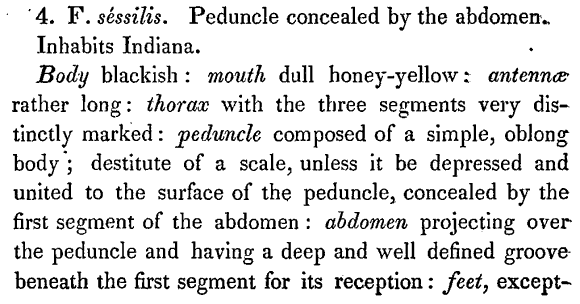
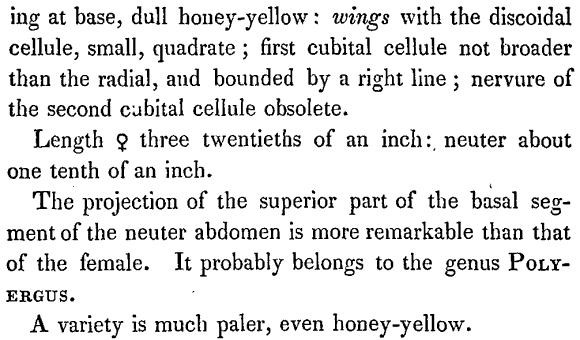
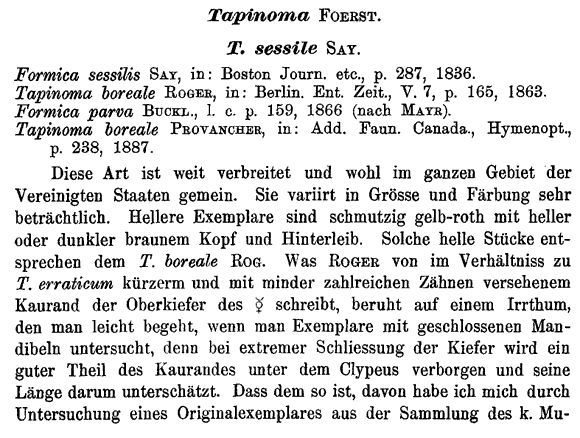

Page authored by David Lubertazzi and Gary Alpert
